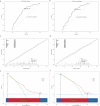AI prediction model for endovascular treatment of vertebrobasilar occlusion with atrial fibrillation
- PMID: 39894819
- PMCID: PMC11788420
- DOI: 10.1038/s41746-025-01478-5
AI prediction model for endovascular treatment of vertebrobasilar occlusion with atrial fibrillation
Abstract
Endovascular treatment (EVT) for vertebrobasilar artery occlusion (VBAO) with atrial fibrillation presents complex clinical challenges. This comprehensive multicenter study of 525 patients across 15 Chinese provinces investigated nuanced predictors beyond conventional metrics. While 45.1% achieved favorable outcomes at 90 days, our advanced machine learning approach unveiled subtle interaction effects among clinical variables not captured by traditional statistical methods. The predictive model distinguished high-risk subgroups by integrating multiple parameters, demonstrating superior prognostic precision compared to standard NIHSS-based assessments. Novel findings include nonlinear relationships between dyslipidemia, stroke severity, and functional recovery. The developed predictive algorithm (AUC 0.719 internally, 0.684 externally) offers a more sophisticated risk stratification tool, potentially guiding personalized treatment strategies in high-complexity VBAO patients with atrial fibrillation.
© 2025. The Author(s).
Conflict of interest statement
Competing interests: The authors declare no competing interests.
Figures



References
-
- Singer, O. C. et al. Mechanical recanalization in basilar artery occlusion: the ENDOSTROKE study. Ann. Neurol.77, 415–424 (2015). - PubMed
-
- Nguyen, T. N. & Strbian, D. Endovascular Therapy for Stroke due to Basilar Artery Occlusion: A BASIC Challenge at BEST. Stroke52, 3410–3413 (2021). - PubMed
-
- Liu, X. et al. Endovascular treatment versus standard medical treatment for vertebrobasilar artery occlusion (BEST): an open-label, randomised controlled trial. Lancet Neurol.19, 115–122 (2020). - PubMed
-
- Langezaal, L. C. M. et al. Endovascular Therapy for Stroke Due to Basilar-Artery Occlusion. N. Engl. J. Med.384, 1910–1920 (2021). - PubMed
-
- Jovin, T. G. et al. Trial of Thrombectomy 6 to 24 h after Stroke Due to Basilar-Artery Occlusion. N. Engl. J. Med.387, 1373–1384 (2022). - PubMed
Grants and funding
- 2023IHM01052/Research Funds of Centre for Leading Medicine and Advanced Technologies of IHM
- 2023IHM01050/Research Funds of Centre for Leading Medicine and Advanced Technologies of IHM
- 2023IHM01050/Research Funds of Centre for Leading Medicine and Advanced Technologies of IHM
- 2024B03J0436/the Science and Technology Program of Guangzhou, China
LinkOut - more resources
Full Text Sources

